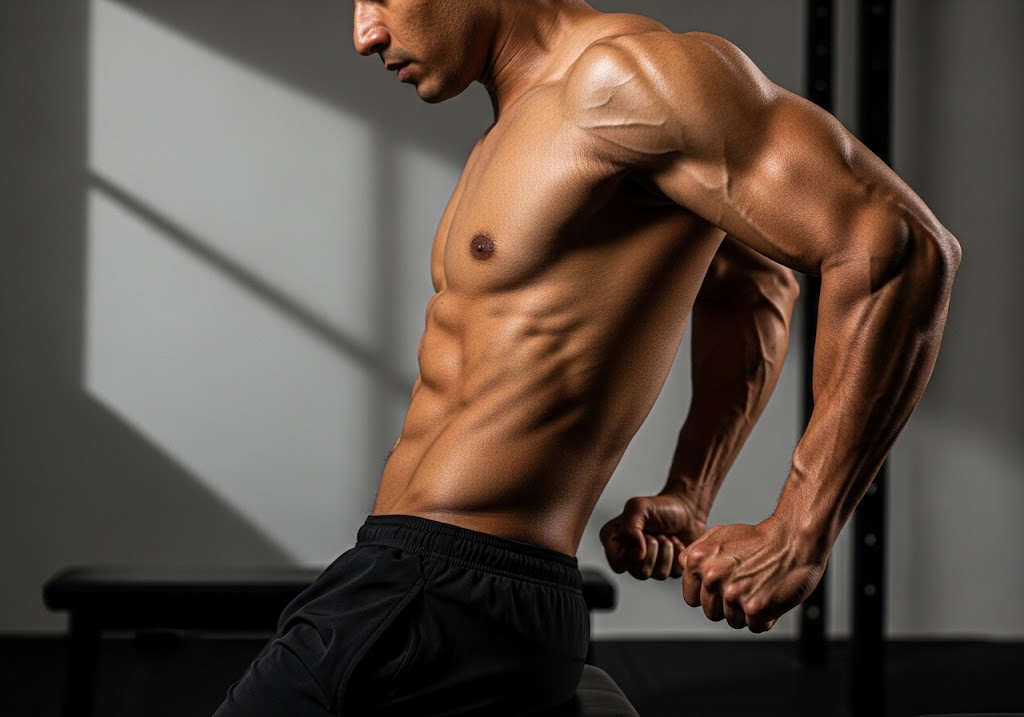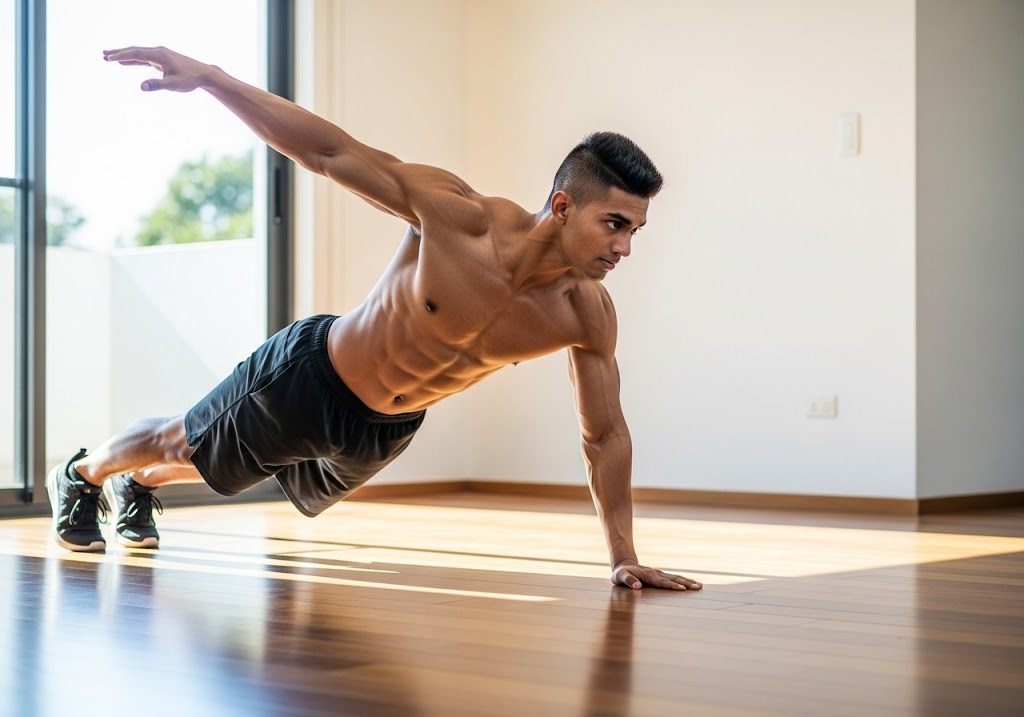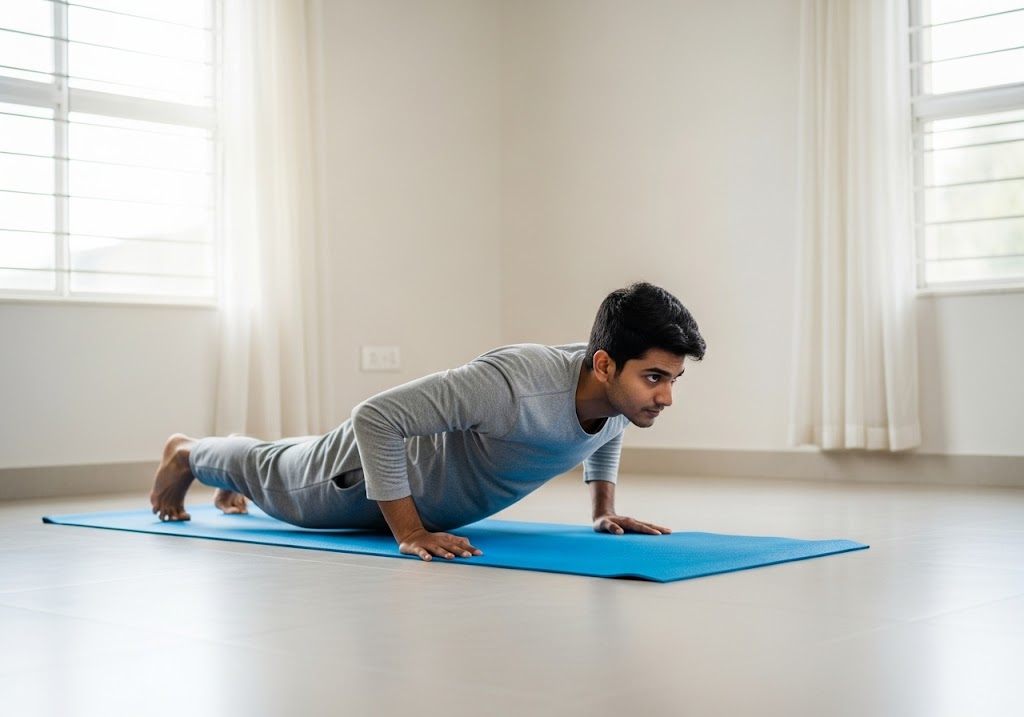Yes, calisthenics can effectively build muscle. While it may not lead to the same degree of extreme muscle mass as some weightlifting routines, calisthenics can still produce significant muscle growth and strength gains through progressive overload and proper technique.
The question “does calisthenics build muscle?” has sparked countless debates in fitness circles. Many people wonder if bodyweight exercises can deliver the same muscle-building results as traditional weight training. The simple answer is yes – does calisthenics build muscle? Absolutely, when done correctly. This comprehensive guide explores the science behind muscle growth through calisthenics, debunks common myths, and provides practical strategies for maximizing your results. Whether you’re a beginner or experienced athlete, understanding how calisthenics build muscle will transform your training approach and help you achieve impressive physique changes.
Table of Contents
Does Calisthenics Build Muscle? The Direct Answer
Yes, does calisthenics build muscle? The answer is definitively yes, and this fact is supported by extensive scientific research and countless real-world examples. When people ask does calisthenics build muscle, they’re often surprised to learn that bodyweight training can produce muscle growth comparable to traditional weight training when proper principles are applied.
The key to understanding does calisthenics build muscle lies in recognizing that your muscles respond to resistance and tension, regardless of the source. Whether resistance comes from weights or your body weight, the muscle-building mechanisms remain the same. Research consistently shows that calisthenics build muscle effectively through progressive overload, mechanical tension, and metabolic stress – the same principles that drive growth in any successful training program.
Is Calisthenics Good for Building Muscle?
Calisthenics is highly effective for building lean muscle mass through progressive bodyweight resistance training. Compound movements like push-ups, pull-ups, and squats engage multiple muscle groups simultaneously, promoting functional strength development. The progressive overload principle applies through advanced variations, increased repetitions, and enhanced time under tension, stimulating muscle protein synthesis effectively.
However, calisthenics has limitations for maximum muscle hypertrophy compared to weighted resistance training. Upper body muscle building may plateau without external resistance, particularly for advanced trainees. To optimize muscle growth, combine basic movements with challenging progressions like archer push-ups, pistol squats, and weighted variations when bodyweight becomes insufficient for continued adaptation.
Find out the calorie burn behind those core moves: how many calories do Russian twists burn

How Does Calisthenics Build Muscle?
When people wonder does calisthenics build muscle, they need to understand the fundamental mechanisms involved. Calisthenics builds muscle through the same proven pathways as traditional resistance training, creating mechanical tension and metabolic stress that stimulate muscle growth and adaptation.
- Progressive Overload: Gradually increasing exercise difficulty through variations, repetitions, or time under tension
- Mechanical Tension: Creating force within muscle fibers through challenging bodyweight resistance
- Metabolic Stress: Building up metabolic byproducts that signal muscle growth and adaptation
- Muscle Fiber Recruitment: Activating more muscle fibers as exercises become more challenging
- Time Under Tension: Extending muscle contraction periods through controlled, deliberate movements
- Compound Movement Patterns: Engaging multiple muscle groups simultaneously for comprehensive development
Want bigger arms with zero weights: how to make biceps at home without dumbbells
Science Behind Calisthenics Muscle Building
Scientific research provides clear evidence that does calisthenics build muscle effectively. Studies comparing bodyweight training to traditional weight training consistently show similar muscle growth outcomes when training variables are properly matched and progression is systematically applied.
- Muscle Protein Synthesis: Bodyweight exercises elevate protein synthesis rates for up to 48 hours post-workout
- Hormonal Response: Calisthenics exercises trigger growth hormone, testosterone, and IGF-1 release
- Satellite Cell Activation: Essential cells for muscle repair and growth activate robustly during calisthenics training
- Muscle Fiber Recruitment: Both slow-twitch and fast-twitch fibers engage during challenging bodyweight movements
- Neural Adaptations: Improved motor unit recruitment enhances force production and muscle building potential
- Inflammatory Response: Controlled muscle damage from calisthenics triggers beneficial growth adaptations
Curious about fat burn in leg training: calories burned in lunges
Best Calisthenics Exercises for Building Muscle
The most effective exercises for those wondering does calisthenics build muscle are compound movements that challenge multiple muscle groups simultaneously. These exercises provide maximum muscle building stimulus while developing functional strength and coordination throughout the body.
| Exercise | Primary Muscles | Secondary Muscles | Difficulty Level |
| Push-ups | Chest, Triceps, Shoulders | Core, Serratus Anterior | Beginner to Advanced |
| Pull-ups | Lats, Rhomboids, Biceps | Middle Traps, Rear Delts | Intermediate to Advanced |
| Dips | Chest, Triceps, Front Delts | Core, Serratus Anterior | Intermediate |
| Squats | Quadriceps, Glutes | Hamstrings, Calves, Core | Beginner to Advanced |
| Handstand Push-ups | Shoulders, Triceps | Upper Chest, Core | Advanced |
| Pistol Squats | Quadriceps, Glutes | Hamstrings, Calves, Core | Advanced |
| Burpees | Full Body | Cardiovascular System | Beginner to Intermediate |
| L-Sits | Core, Hip Flexors | Shoulders, Triceps | Intermediate to Advanced |
Detailed Exercise Instructions
1. Push-ups
Push-ups represent the foundation of upper body calisthenics muscle building, targeting chest, triceps, and shoulders while engaging core stabilizers. This versatile exercise offers infinite progression possibilities from knee push-ups to single-arm variations. The compound nature makes push-ups essential for developing functional pressing strength while building lean muscle mass throughout the upper body and core region.
How to Do Push-ups?
- Start in high plank position with hands slightly wider than shoulder-width
- Keep body in perfect straight line from head to heels throughout
- Lower chest toward ground by bending elbows at 45-degree angle
- Descend until chest nearly touches floor or comfortable depth
- Push through palms explosively to return to starting position
- Maintain core engagement and neutral spine throughout movement
- Control both eccentric and concentric phases for maximum muscle activation
2. Pull-ups
Pull-ups are the ultimate upper body muscle builder, primarily targeting the latissimus dorsi, rhomboids, and biceps while engaging numerous stabilizing muscles. This challenging exercise develops exceptional back width and thickness while building functional pulling strength essential for overall upper body development. Progress from assisted variations to weighted pull-ups for continued muscle growth and strength advancement.
How to Do Pull-ups?
- Hang from pull-up bar with overhand grip, hands shoulder-width apart
- Start with arms fully extended, shoulders actively engaged
- Pull body up by driving elbows down and back toward ribs
- Continue pulling until chin clears bar completely
- Squeeze back muscles maximally at top position
- Lower body with control to full arm extension
- Avoid swinging or using momentum throughout entire movement
3. Dips
Dips provide exceptional muscle building stimulus for the chest, triceps, and anterior deltoids through a unique angle unavailable in push-ups. This compound movement allows for significant loading progression and targets the lower chest particularly effectively. Dips can be performed on parallel bars, rings, or chairs, making them accessible while providing serious muscle building potential for intermediate practitioners.
How to Do Dips?
- Support body weight on parallel bars or stable chairs
- Keep shoulders directly over wrists with arms extended
- Lower body by bending elbows straight back, not flaring outward
- Descend until shoulders are slightly below elbow level
- Drive through palms to press back to starting position
- Keep torso upright and legs straight throughout movement
- Control descent and avoid bouncing at bottom position
4. Squats
Squats are the king of lower body muscle building exercises, targeting the quadriceps and glutes while engaging the entire kinetic chain. This fundamental movement pattern builds functional strength and muscle mass in the body’s largest muscle groups, creating significant metabolic demand for overall muscle growth. Progress from bodyweight to single-leg variations for continued development and increased challenge.
How to Do Squats?
- Stand with feet shoulder-width apart, toes slightly pointed outward
- Keep chest up and maintain natural spinal curves throughout
- Initiate movement by pushing hips back like sitting in chair
- Lower until thighs are parallel to ground or comfortable depth
- Keep knees tracking over toes, avoiding inward collapse
- Drive through heels to return to standing position powerfully
- Engage core throughout entire range of motion for stability
5. Handstand Push-ups
Handstand push-ups represent the pinnacle of vertical pressing strength, building exceptional shoulder and tricep muscle mass while developing incredible core stability. This advanced movement requires significant strength, balance, and coordination, making it a true test of upper body power. Progress through wall-assisted variations before attempting freestanding handstand push-ups for optimal safety and development.
How to Do Handstand Push-ups?
- Start in handstand position against wall for support and balance
- Keep arms straight and core maximally engaged throughout
- Lower head toward ground by bending elbows forward
- Descend until head gently touches floor or comfortable depth
- Press explosively back to full arm extension
- Maintain straight body line and avoid excessive arching
- Master wall-assisted version before progressing to freestanding
6. Pistol Squats
Pistol squats are the ultimate single-leg strength and muscle building exercise, demanding exceptional balance, flexibility, and unilateral leg power. This advanced movement targets the quadriceps and glutes intensely while correcting muscle imbalances between legs. The demanding nature makes pistol squats incredibly effective for building functional strength and lean muscle mass in the lower body.
How to Do Pistol Squats?
- Stand on one leg with other leg extended straight in front
- Keep extended leg parallel to ground throughout movement
- Lower body on standing leg until thigh is parallel to ground
- Keep chest up and arms extended forward for balance
- Drive through heel of standing leg to return to starting position
- Maintain control and avoid falling backward during descent
- Master assisted versions using support before attempting full pistol
7. Burpees
Burpees combine strength training with cardiovascular conditioning, making them exceptional for building full-body muscle while improving metabolic conditioning. This high-intensity exercise works every major muscle group while elevating heart rate significantly, creating optimal conditions for muscle growth and fat loss. The compound nature makes burpees incredibly efficient for overall body transformation and conditioning.
How to Do Burpees?
- Start standing with feet shoulder-width apart, arms at sides
- Squat down quickly and place hands on floor in front of feet
- Jump or step both feet back into high plank position
- Perform one controlled push-up with proper form
- Jump or step feet back toward hands into squat position
- Explosively jump vertically with arms reaching overhead
- Land softly and immediately transition into next repetition
8. L-Sits
L-sits are an isometric core and hip flexor exercise that builds incredible abdominal strength while developing shoulder and tricep endurance. This challenging static hold requires exceptional core control and upper body stability, making it a true test of functional strength. The demanding nature of L-sits makes them incredibly effective for building lean muscle mass in the core region.
How to Do L-Sits?
- Sit on floor with legs extended straight in front of body
- Place hands on floor beside hips, fingers pointing forward
- Press through hands to lift entire body off ground
- Keep legs straight and parallel to ground throughout hold
- Maintain active shoulder position, not sagging between arms
- Hold position for prescribed time while breathing normally
- Progress from bent-knee to straight-leg variations gradually
Learn proper form and technique for chest gains: how to do dumbbell bench press

Can Calisthenics Build Muscle? 15 Detailed Points
Using your bodyweight provides enough resistance to stimulate muscle growth when done correctly. While progress may seem slower than lifting weights, calisthenics develops functional strength, improves body control, and creates lean muscle mass effectively for people of all fitness levels.
1. Progressive Overload
Calisthenics allows for progressive overload, meaning you gradually increase the challenge to your muscles over time. This can be done by progressing to more difficult exercises (like moving from a knee push-up to a regular push-up), increasing the number of repetitions, or using variations that require more effort. You can also slow down movements, add pauses, change angles, or combine exercises to create new challenges. This constant progression ensures your muscles never adapt completely, forcing them to grow stronger and bigger over time.
2. Hypertrophy
Muscle hypertrophy, or muscle growth, occurs when muscle fibers are damaged and then repaired, becoming thicker and stronger. Calisthenics can induce this process by creating enough resistance to trigger muscle damage and subsequent repair. The key is working in the 6-20 repetition range with exercises that challenge your muscles. When you can easily perform 20 reps of an exercise, it’s time to progress to a harder variation to maintain the muscle-building stimulus and continue growing.
3. Bodyweight Exercises
Calisthenics utilizes bodyweight exercises like push-ups, pull-ups, squats, lunges, and planks. These exercises engage multiple muscle groups, promoting overall strength and muscle development. Unlike isolation exercises that target single muscles, bodyweight movements create functional patterns that your body uses daily. This multi-muscle engagement burns more calories, improves coordination, and builds balanced strength throughout your entire body. The natural movement patterns also reduce injury risk compared to artificial machine movements.
4. Individual Differences
While calisthenics can build muscle effectively, the extent of muscle growth may vary based on individual factors such as genetics, diet, and consistency of training. Some people naturally build muscle faster due to genetics, while others need more time and patience. Your starting fitness level, age, sleep quality, and stress levels also impact results. However, regardless of your starting point, consistent calisthenics training will lead to muscle growth and strength improvements when combined with proper nutrition and adequate rest periods.
5. Combining with Weights
Calisthenics and weight training are not mutually exclusive. Many individuals find that combining both methods provides the best results, as weight training can be more efficient for building muscle mass while calisthenics enhances functional strength and body control. You can use weights for heavy, low-rep strength building and calisthenics for higher-rep endurance work. This combination approach prevents boredom, addresses different fitness aspects, and creates a well-rounded physique with both size and functional capability for real-world activities.
Looking for maximal fat loss with muscle retention? This guides you through the best workout to lose weight and gain muscle
6. Time Under Tension
Calisthenics naturally creates longer time under tension, which means your muscles work harder for extended periods. Slow, controlled movements during push-ups or squats keep muscles engaged longer, promoting better muscle growth than quick, rushed repetitions. Research shows that 30-70 seconds of time under tension per set optimizes muscle growth. Calisthenics movements naturally fall into this range, especially when performed with proper form and control. This extended muscle engagement triggers greater metabolic stress, a key driver of muscle hypertrophy.
7. Compound Movements
Most calisthenics exercises are compound movements that work multiple muscle groups simultaneously. A single push-up targets chest, shoulders, triceps, and core muscles together, making workouts more efficient and promoting balanced muscle development throughout your body. This multi-muscle activation burns more calories than isolation exercises and improves functional strength for daily activities. Compound movements also stimulate the release of muscle-building hormones more effectively than single-muscle exercises, creating a better environment for overall muscle growth and development.
8. Metabolic Benefits
Calisthenics workouts often combine strength training with cardiovascular benefits. This combination helps burn calories, reduce body fat, and reveal the muscle you’re building underneath. The result is a leaner, more defined physique with visible muscle definition. The metabolic boost from calisthenics continues even after your workout ends, burning additional calories for hours. This “afterburn effect” helps maintain a healthy body composition, making your muscle development more visible and impressive while improving overall health and fitness levels.
9. Accessibility and Consistency
Since calisthenics requires no equipment or gym membership, it’s easier to maintain consistency. You can exercise anywhere, anytime, which leads to better long-term results. Consistent training is more important for muscle building than occasional intense gym sessions. The convenience factor eliminates common exercise barriers like bad weather, travel, or gym closures. This accessibility means you’re more likely to stick with your routine long-term, and consistency is the most important factor in building muscle and achieving your fitness goals successfully.
10. Functional Strength
Calisthenics builds strength that directly translates to daily activities and sports performance. The muscle you develop helps with real-world movements like climbing stairs, lifting objects, or playing sports, making it practical strength rather than just show muscle. This functional approach improves movement quality, reduces injury risk, and enhances athletic performance in various activities. The strength patterns you develop through calisthenics match how your body naturally moves, creating useful muscle that serves you in everyday life rather than just looking good in the mirror.
Build lean muscle naturally with bodyweight exercises.
11. Recovery and Adaptation
Bodyweight exercises are generally easier on your joints compared to heavy weights. This means faster recovery between workouts, allowing you to train more frequently. More frequent training sessions can lead to better muscle-building results over time. The natural movement patterns of calisthenics reduce stress on joints, ligaments, and tendons while still providing adequate stimulus for muscle growth. This gentler approach allows you to maintain higher training frequency without overuse injuries, leading to consistent progress and better long-term muscle development.
12. Volume and Frequency
With calisthenics, you can easily adjust workout volume by adding more sets, reps, or exercise variations. Higher training frequency and volume are key factors in muscle growth, and bodyweight exercises make it simple to increase both without equipment limitations. You can train the same muscles multiple times per week since recovery demands are lower than heavy weight training. This increased frequency allows for more practice, skill development, and muscle stimulation throughout the week, leading to faster strength gains and muscle growth compared to traditional once-per-week body part splits.
13. Mind-Muscle Connection
Calisthenics helps develop a better mind-muscle connection because you must control your entire body through each movement. This improved awareness allows you to better target specific muscles, leading to more effective workouts and better muscle activation during exercises. The complex nature of bodyweight movements requires focus and concentration, strengthening the neural pathways between your brain and muscles. This enhanced connection improves exercise form, reduces injury risk, and maximizes muscle recruitment during workouts, leading to better results and faster progress in your fitness journey.
14. Plateau Breaking
When you hit a plateau with basic exercises, calisthenics offers endless variations to challenge your muscles differently. You can try single-arm push-ups, pistol squats, or archer pull-ups to break through strength barriers and continue building muscle when standard exercises become too easy. The progression system in calisthenics is virtually limitless, with advanced moves like planche, front lever, and human flag providing years of challenging goals. This variety keeps workouts interesting while continuously challenging your muscles in new ways, preventing adaptation and ensuring continued growth.
15. Hormonal Benefits
Regular calisthenics training naturally boosts muscle-building hormones like growth hormone and testosterone while reducing stress hormones like cortisol. This hormonal environment supports muscle growth, fat loss, and overall recovery, creating optimal conditions for building lean muscle mass naturally. The combination of resistance training and cardiovascular benefits triggers positive hormonal responses that enhance muscle protein synthesis, improve sleep quality, and increase energy levels. These hormonal improvements extend beyond just muscle building, supporting overall health, mood, and well-being for a better quality of life.
Strengthen your posterior chain with these essential back calisthenics exercises.
Which Type of Calisthenics is Best for Muscle Gain?
Progressive Calisthenics offers the most effective approach for muscle building by systematically advancing from basic to advanced movement variations. This method applies progressive overload through increased difficulty rather than added weight. Movements like progressing from standard push-ups to archer push-ups, then single-arm push-ups create continuous muscle-building stimulus. Combined with weighted calisthenics using vests, belts, or resistance bands, this approach maximizes hypertrophy potential while maintaining bodyweight training benefits.
Compound movement-focused calisthenics targeting multiple muscle groups simultaneously proves most efficient for overall muscle development. Pull-ups, dips, pistol squats, and handstand push-ups engage numerous muscles while allowing significant strength progression. Tempo-controlled training with slower negatives (3-5 seconds) increases time under tension, a crucial factor for muscle growth. This combination of progressive skills, compound movements, and controlled tempos creates optimal conditions for building lean muscle mass through calisthenics training.
Calisthenics vs Weight Training for Muscle Building
When comparing training methods, does calisthenics build muscle as effectively as weight training? Research indicates both methods can produce similar muscle growth when volume and intensity are properly matched. The choice often depends on individual preferences, goals, and circumstances.
| Factor | Calisthenics | Weight Training |
| Muscle Building Potential | High with proper progression | High with linear progression |
| Progressive Overload | Exercise variations and volume | Adding weight incrementally |
| Convenience | High – no equipment needed | Low – requires gym access |
| Functional Strength | Excellent – natural movement patterns | Good – depends on exercise selection |
| Injury Risk | Lower – bodyweight resistance | Higher – external load risks |
| Cost | Free after initial learning | Expensive – gym/equipment costs |
| Learning Curve | Moderate – skill development needed | Low – straightforward progression |
| Muscle Isolation | Difficult – compound movements | Easy – isolation exercises available |
Which builds upper-body strength better: push ups or the bench press? push ups vs bench press
How to Maximize Muscle Building with Calisthenics?
For those serious about does calisthenics build muscle, maximizing results requires strategic programming and consistent progressive overload. The key lies in continuously challenging your muscles through exercise progressions, increased volume, and optimized recovery protocols.
Focus on mastering fundamental movements before advancing to complex variations. Perfect your calisthenics chest exercises like push-ups before attempting handstand push-ups. This foundation ensures proper form and reduces injury risk while building the strength necessary for advanced progressions. Track your progress meticulously, recording repetitions, sets, and exercise variations to ensure continuous advancement and maintain motivation throughout your muscle-building journey.
Just getting started? Here’s how to begin: how to start calisthenics

Common Myths About Calisthenics and Muscle Building
Despite clear evidence that does calisthenics build muscle, several persistent myths continue to circulate. These misconceptions often discourage people from pursuing bodyweight training for muscle building goals, despite its proven effectiveness for developing impressive physiques.
- Myth: Calisthenics only builds endurance, not muscle mass
- Truth: Proper progression and intensity in calisthenics builds significant muscle mass
- Myth: You need weights to build serious muscle
- Truth: Bodyweight resistance can be equally effective for muscle growth
- Myth: Calisthenics can’t provide enough resistance for muscle building
- Truth: Advanced progressions like one-arm push-ups provide massive resistance
- Myth: Calisthenics only builds lean muscle without bulk
- Truth: Nutrition and training volume determine muscle size, not exercise type
- Myth: You can’t progressively overload with bodyweight exercises
- Truth: Countless progression methods exist for continuous challenge
Find out the most efficient fat-burning cardio move to maximize your results: which cardio exercise burns the most calories

Nutrition for Calisthenics Muscle Building
Proper nutrition plays a crucial role in supporting the question does calisthenics build muscle. Your diet provides the raw materials necessary for muscle protein synthesis, recovery, and adaptation to training stimulus from bodyweight exercises.
| Nutrient | Daily Requirement | Role in Muscle Building | Best Sources |
| Protein | 1.6-2.2g per kg body weight | Muscle protein synthesis | Lean meats, fish, eggs, dairy, legumes |
| Carbohydrates | 4-6g per kg body weight | Energy for workouts | Rice, oats, fruits, vegetables |
| Fats | 0.8-1.2g per kg body weight | Hormone production | Nuts, olive oil, avocados, fish |
| Calories | Slight surplus (200-500) | Energy for muscle growth | Whole foods, balanced meals |
| Water | 35-40ml per kg body weight | Hydration and recovery | Water, herbal teas, fruits |
| Timing | Post-workout protein | Optimize recovery | Within 2 hours of training |
See how effective the leg press is for fat loss and muscle gain in calories burned doing leg press

Creating Your Home Workout Space for Building Muscle
Effective calisthenics muscle building requires minimal space but benefits from thoughtful setup. You need enough room to perform exercises safely without hitting furniture or walls. A space roughly 6 feet by 6 feet provides adequate room for most routines that answer does calisthenics build muscle.
Clear your workout area of obstacles and ensure adequate ceiling height for jumping movements. Good lighting helps you maintain proper form and prevents accidents during your sessions. Proper ventilation keeps you comfortable and helps regulate body temperature during intense workouts. Consider incorporating calisthenics ab workout routines that require minimal space but deliver maximum core muscle building results.
Progressive Training Strategies for Build Muscle
Understanding does calisthenics build muscle requires mastering progressive training strategies. Start with basic movements and gradually advance to more challenging variations as your strength and skill develop. This systematic approach ensures continuous muscle building stimulus while minimizing injury risk.
Focus on perfecting form before increasing difficulty. Master standard push-ups before attempting calisthenics wide grip pull-ups or advanced variations. Quality movement patterns build the foundation for long-term success in muscle building with calisthenics.
Track your progress through various metrics including repetitions, time under tension, and exercise difficulty. This data helps you understand how does calisthenics build muscle in your specific case and guides program adjustments for optimal results.
Curious about calorie burn in isolation exercises? Learn the stats and variations in how many calories do leg curls burn

Calisthenics Build Muscle: Advanced Muscle Building Techniques
For experienced practitioners wondering does calisthenics build muscle at advanced levels, several techniques can enhance muscle growth. Tempo manipulation, isometric holds, and plyometric variations all contribute to increased muscle building stimulus.
Incorporate calisthenics close grip pull-ups for enhanced bicep development and calisthenics leg exercises for comprehensive lower body muscle building. These targeted approaches ensure balanced development while answering does calisthenics build muscle across all body regions.
Consider combining different exercise types within your routine. Mix strength-focused movements with endurance challenges to create comprehensive muscle building stimulus. This variety prevents adaptation and maintains the muscle building momentum that answers does calisthenics build muscle effectively.
Looking for maximal fat loss with muscle retention? This guides you through the best workout to lose weight and gain muscle
Calisthenics Build Muscle: Recovery and Muscle Building
Recovery plays a crucial role in answering does calisthenics build muscle. Your muscles grow during rest periods, not during workouts. Adequate sleep, proper nutrition, and strategic rest days maximize your muscle building potential from calisthenics training.
Prioritize sleep quality and quantity for optimal muscle building results. Aim for 7-9 hours of quality sleep nightly to support recovery and growth hormone release. Poor sleep significantly impairs your body’s ability to build muscle, regardless of training quality.
Include active recovery activities like light stretching, walking, or calisthenics biceps exercises on rest days. These activities promote blood flow and recovery without interfering with the muscle building process that answers does calisthenics build muscle.

Does Calisthenics Build Muscle? – Conclusion
The question “does calisthenics build muscle?” has a clear, science-backed answer: absolutely yes. Calisthenics builds muscle effectively through the same mechanisms as traditional weight training – mechanical tension, metabolic stress, and progressive overload. The key to success lies in proper programming, consistent progression, and adequate recovery.
Understanding that calisthenics builds muscle empowers you to pursue bodyweight training with confidence. Whether you’re a beginner starting with basic exercises or an advanced athlete mastering complex movements, calisthenics provides a sustainable, effective path to muscle building. The convenience, functionality, and scalability of bodyweight training make it an excellent choice for anyone serious about building muscle and improving their physique.
Want to master the calisthenics handstand and take your skills to the next level? Whether you’re a beginner or pushing advanced skills, ISC – Indian School of Calisthenics offers expert guidance to help you master bodyweight training. Visit us at SRPF Ground, NH8, Goregaon (E), Mumbai – 400065. For class schedules, personalized coaching, or more details, call +91 77159 53218. Train smart, move better, and unlock your back strength with ISC.
Does Calisthenics Build Muscle? – FAQs
Can calisthenics build muscle as effectively as weight training?
Yes, research shows calisthenics builds muscle equally effectively as weight training when volume and intensity are matched. Both methods create necessary stimulus for growth.
How long does it take to build muscle with calisthenics?
Visible muscle growth typically occurs within 6-12 weeks of consistent calisthenics training, with significant changes appearing after 3-6 months of proper programming.
What muscles does calisthenics build most effectively?
Calisthenics builds all major muscle groups effectively, with particular strength in developing functional, compound muscle development throughout the entire body.
Do I need to eat differently when building muscle with calisthenics?
Yes, muscle building requires adequate protein (1.6-2.2g/kg body weight) and slight caloric surplus regardless of training method, including calisthenics.
Can skinny people build muscle with calisthenics?
Absolutely! Skinny individuals often respond very well to calisthenics muscle building due to lower body weight making exercises more manageable initially.
Is calisthenics better than weights for building muscle?
Neither is inherently better – both build muscle effectively. Calisthenics offers convenience and functionality while weights provide easier progressive overload.
How often should I do calisthenics to build muscle?
Train each muscle group 2-3 times per week with calisthenics for optimal muscle building, allowing at least 48 hours recovery between sessions.
Can you get bulky from calisthenics?
Yes, calisthenics can build significant muscle mass leading to a bulky appearance when combined with proper nutrition and progressive training.
Do calisthenics build muscle faster than weights?
Muscle building speed is similar between calisthenics and weights when volume and intensity are equal. Individual response varies more than training method.
What’s the best calisthenics exercise for building muscle?
Pull-ups and push-ups are among the most effective single exercises, but compound movements like burpees provide comprehensive muscle building benefits.


